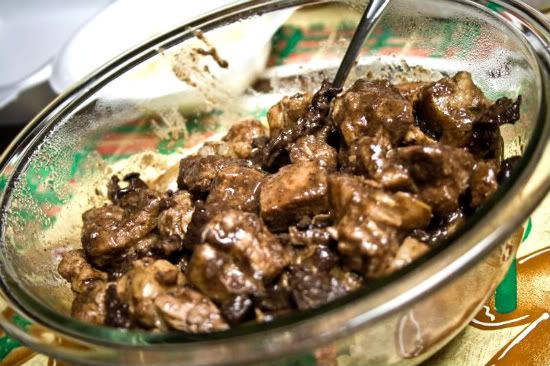These dishes are your typical filipino dishes, Diniguan, Lechon, Beef steak, Ginataang Alimasag (crabs in coconut milk)
Dinuguan (also called dinardaraan in Ilocano and tid-tad in Pampanga, or possible English translations: pork blood stew, blood pudding stew) is a Filipino savory stew of blood and meat (typically stomach, intestines, ears, heart and snout) simmered in a rich, spicy dark gravy of pig blood, garlic, chili (most often siling mahaba), and vinegar. The term dinuguan comes from the Filipino word dugo meaning "blood". It is frequently considered an unusual or alarming dish to most people, though it is rather similar to European-style blood sausage, or British black pudding in a saucy stew form. It is perhaps closer in appearance and preparation to the ancient Spartan dish known as melas zomos (black soup) whose primary ingredients were pork, vinegar and blood. Dinuguan is often served with white rice or a Philippine rice cake called puto. It has earned the nickname of chocolate meat for its appearance.

n the Philippines, lechón is often served with vinegar, lechon sauce (made out of chicken livers or liver pate combined with vinegar, garlic, and pepper),[5] plum sauce, or other sauces, or with other seasonings or accompaniments. When serving lechon, it is usually well decorated with vegetables in a big plate and an apple is placed on the pig's mouth. Another variation, known as Pritchon, consists of a deep-fried piglet chopped into small pieces and wrapped in pita wedges (à la Peking Duck), and served with an array of special sauces.

Beef Steak is pretty much it, adding onions and the soy sauce and vinegar very easy to cook and also fast to serve, my favorite!

This dish is one of my favorites as well, the coconut and the crab blended flavors really make the dish. The use of gata (coconut milk) in cooking is very common among coconut-rich towns in Mindanao. Mountains of coconut trees are seen in the countryside and even lining up beaches, providing a year-round source of coconut milk since a mature tree blooms up to 13 times a year.("Jay-ar Mendoza")


No comments:
Post a Comment